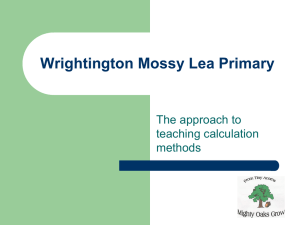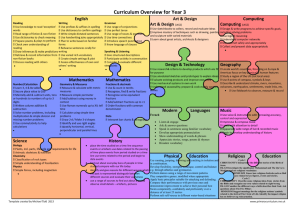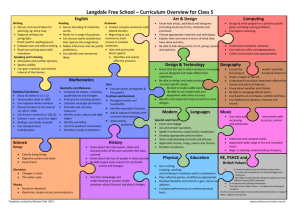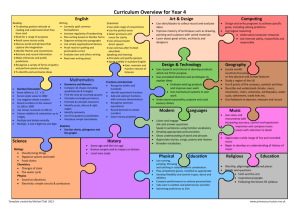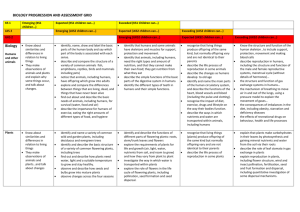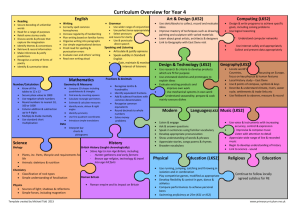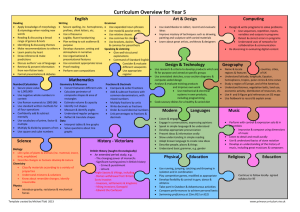Curriculum Overview for Year - St Ebbe's CE (Aided) Primary School
advertisement
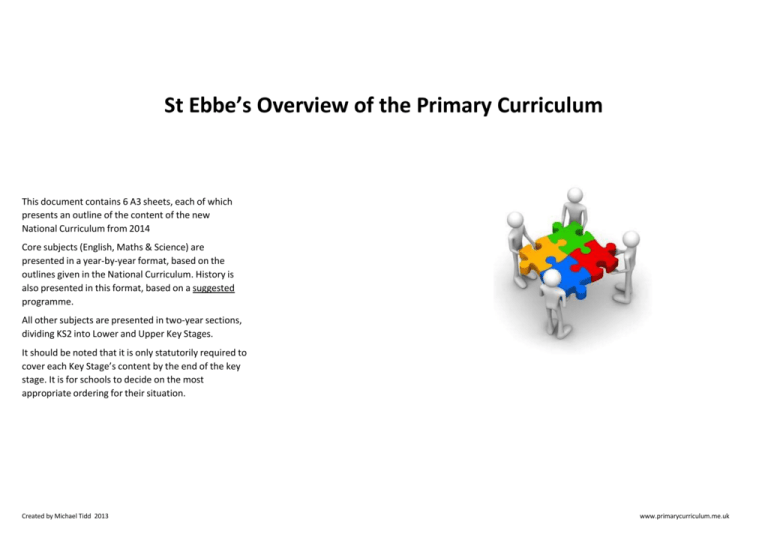
St Ebbe’s Overview of the Primary Curriculum This document contains 6 A3 sheets, each of which presents an outline of the content of the new National Curriculum from 2014 Core subjects (English, Maths & Science) are presented in a year-by-year format, based on the outlines given in the National Curriculum. History is also presented in this format, based on a suggested programme. All other subjects are presented in two-year sections, dividing KS2 into Lower and Upper Key Stages. It should be noted that it is only statutorily required to cover each Key Stage’s content by the end of the key stage. It is for schools to decide on the most appropriate ordering for their situation. Created by Michael Tidd 2013 www.primarycurriculum.me.uk Curriculum Overview for Year 1 Art & Design (KS1) English Reading Writing Match graphemes for all phonemes Name letters of the alphabet Read accurately by blending Spell very common ‘exception’ sounds words Read words with very common Spell days of the week suffixes Use very common prefixes & Read contractions & understand suffixes purpose Form lower case letters correctly Read phonics books aloud Form capital letters & digits Link reading to own experiences Compose sentences orally before Join in with predictable phrases writing Discuss significance of title & Read own writing to peers or events teachers Make simple predictions Grammar Leave spaces between words Begin to use basic punctuation: . ? ! Use capital letters for proper nouns. Use common plural & verb suffixes Speaking & Listening Listen & respond appropriately Ask relevant questions Maintain attention & participate Geometry & Measures Use common vocabulary for comparison, e.g. heavier, taller, full, longest, quickest Begin to measure length, capacity, weight Recognise coins & notes Use time & ordering vocabulary Tell the time to hour/half-hour Use language of days, weeks, months & years Recognise & name common 2-d and 3-d shapes Order & arrange objects Science Biology Identify basic plants Identify basic plant parts (roots, leaves, flowers, etc.) Identify & compare common animals Identify & name basic body parts Chemistry Distinguish between objects & materials Identify & name common materials Describe simple properties of some materials Compare & classify materials Physics Observe weather associated with changes of season Created by Michael Tidd 2013 Use a range of materials Understand use of algorithms Use drawing, painting and sculpture Write & test simple programs Develop techniques of colour, pattern, texture, line, shape, form and space Learn about range of artists, craftsmen and designers Design & Technology (KS1) Design purposeful, functional & appealing products Use logical reasoning to make predictions Organise, store, retrieve & manipulate data Communicate online safely and respectfully Recognise uses of IT outside of school Geography (Y1) Generate, model & communicate ideas Mathematics Number/Calculation Count to / across 100 Count in 1s, 2s, 5s and 10s Identify ‘one more’ and ‘one less’ Read & write numbers to 20 Use language, e.g. ‘more than’, ‘most’ Use +, - and = symbols Know number bonds to 20 add and subtract one-digit and two-digit numbers to 20, including zero Solve one-step problems, including simple arrays Computing (KS1) Describe position & movement, including half and quarter turns Fractions Recognise & use ½ & ¼ Use range of tools & materials to complete practical tasks Evaluate existing products & own ideas Build and improve structure & mechanisms Understand where food comes from Modern Languages Not required at KS1 History (KS1) Key Events e.g. Bonfire night Events of local importance Music (KS1) Sing songs Play tuned & untuned instruments musically Listen & understand live and recorded music Make and combine sounds musically Key Concepts Changes in living memory (linked to aspects of national life where appropriate) Key Individuals Lives of significant historical figures, including comparison of those from different periods Significant local people Name & locate the four countries and capital cities of the United Kingdom using atlases & globes identify seasonal / daily weather patterns in the UK and the location of hot and cold areas of the world Use basic geographical vocabulary to refer to local & familiar features Use four compass directions & simple vocab Physical Education (KS1) Master basic movement, e.g. running, jumping, throwing, catching, balance, agility and co-ordination Participate in team games Perform dances using simple movement Swimming proficiency at 25m (KS1 or KS2) Religious Education Continue to follow locallyagreed syllabus for RE www.primarycurriculum.me.uk Curriculum Overview for Year 2 Art & Design (KS1) English Reading Writing Grammar Develop phonics until decoding Spell by segmenting into phonemes Use . ! ? , and ’ secure Learn to spell common ‘exception’ Use simple conjunctions words Read common suffixes Begin to expand Read & re-read phonic-appropriate Spell using common suffixes, etc. noun phrases books Use appropriate size letters & Use some features of standard English Read common ‘exception’ words spaces Speaking & Listening Discuss & express views about Develop positive attitude & stamina for writing fiction, non-fiction & poetry Articulate & Justify answers Begin to plan ideas for writing Initiate & respond to comments Become familiar with & retell stories Record ideas sentence-by-sentence Use spoken language to develop Ask & answer questions; make understanding Make simple additions & changes predictions after proof-reading Begin to make inferences Mathematics Geometry & Measures Fractions Know 2, 5, 10x tables Begin to use place value (T/U) Count in 2s, 3s, 5s & 10s Identify, represent & estimate numbers Compare / order numbers, inc. < > = Write numbers to 100 Know number facts to 20 (+ related to 100) Use x and ÷ symbols Recognise commutative property of multiplication Know and use standard measures Read scales to nearest whole unit Use symbols for £ and p and add/subtract simple sums of less than £1 or in pounds Tell time to the nearest 5 minutes Identify & sort 2-d & 3-d shapes Identify 2-d shapes on 3-d surfaces Order and arrange mathematical objects Use terminology of position & movement Find and write simple fractions Understand equivalence of e.g. 2/4 = 1/2 Data Interpret simple tables & pictograms Ask & answer comparison questions Ask & answer questions about totalling Science Biology Differentiate living, dead and non-living Growing plants (water, light, warmth) Basic needs of animals & offspring Simple food chains & habitats Chemistry Identify and compare uses of different materials Compare how things move on different surfaces Use a range of materials Understand use of algorithms Use drawing, painting and sculpture Develop techniques of colour, pattern, texture, line, shape, form and space Write & test simple programs Use logical reasoning to make predictions Learn about range of artists, craftsmen and designers Organise, store, retrieve & manipulate data Communicate online safely and respectfully Recognise uses of IT outside of school Design & Technology (KS1) Design purposeful, functional & appealing products Use range of tools & materials to complete practical tasks Evaluate existing products & own ideas Build and improve structure & mechanisms Understand where food comes from Modern Languages Geography (Y2) Name & locate world’s continents and oceans Compare local area to a non-European country Use basic vocabulary to describe a less familiar area Use aerial images and other models to create simple plans and maps, using symbols Use simple fieldwork and observational skills to study the immediate environment Music (KS1) Sing songs Play tuned & untuned instruments musically Listen & understand live and recorded music Make and combine sounds musically Not required at KS1 History (KS1) Key Concepts Changes in living memory (linked to aspects of national life where appropriate) Key Individuals Lives of significant historical figures, including comparison of those from different periods Significant local people Key Events e.g. Bonfire night Events of local importance Created by Michael Tidd 2013 Generate, model & communicate ideas Number/Calculation Computing (KS1) Physical Education (KS1) Master basic movement, e.g. running, jumping, throwing, catching, balance, agility and co-ordination Participate in team games Perform dances using simple movement Swimming proficiency at 25m (KS1 or KS2) Religious Education Continue to follow locallyagreed syllabus for RE www.primarycurriculum.me.uk English Reading Writing Use knowledge to read ‘exception’ Use prefixes & suffixes in spelling words Use dictionary to confirm spellings Read range of fiction & non-fiction Write simple dictated sentences Use dictionaries to check meaning Use handwriting joins appropriately Prepare poems & plays to perform Plan to write based on familiar Check own understanding of forms reading Rehearse sentences orally for Draw inferences & make writing predictions Use varied rich vocabulary Retrieve & record information from Create simple settings & plot non-fiction books Assess effectiveness of own and Discuss reading with others others’ writing Curriculum Overview for Year 3 Art & Design (LKS2) Grammar Use range of conjunctions Use perfect tense Use range of nouns & pronouns Use time connectives Introduce speech punctuation Know language of clauses Speaking & Listening Give structured descriptions Participate activity in conversation Consider & evaluate different viewpoints Mathematics Number/Calculation Learn 3, 4 & 8x tables Secure place value to 100 Mentally add & subtract units, tens or hundreds to numbers of up to 3 digits Written column addition & subtraction Solve number problems, including multiplication & simple division and missing number problems Use commutativity to help calculations Geometry & Measures Measure & calculate with metric measures Measure simple perimeter Add/subtract using money in context Use Roman numerals up to XII; tell time Calculate using simple time problems Draw 2-d / Make 3-d shapes Identify and use right angles Identify horizontal, vertical, perpendicular and parallel lines Science Biology Plants, incl. parts, lifecycle and requirements for life Animals: skeletons & nutrition Fractions & decimals Use & count in tenths Recognise, find & write fractions Recognise some equivalent fractions Add/subtract fractions up to <1 Order fractions with common denominator Data Interpret bar charts & pictograms Created by Michael Tidd 2013 Improve mastery of techniques such as drawing, painting and sculpture with varied materials Learn about great artists, architects & designers Design & Technology (LKS2) Use research& criteria to develop products which are fit for purpose Use annotated sketches and prototypes to explain ideas Evaluate existing products and improve own work Use mechanical systems in own work Understand seasonality; prepare & cook mainly savoury dishes Modern History British History (taught chronologically) Stone Age to Iron Age Britain, including: - hunter-gatherers and early farmers - Bronze age religion, technology & travel - Iron age hill forts Broader History Study A local history study, e.g. - A depth study linked to a studied period - A study over a period of time - A post-1066 study of relevant local history Design & write programs to achieve specific goals, including solving problems Use logical reasoning Understand computer networks Use internet safely and appropriately Collect and present data appropriately Geography (LKS2) Locate world’s countries, focussing on Europe & Americas focus on key physical & human features Study a region of the UK (not local area) Use 8 points of compass, symbols & keys Describe & understand climate, rivers, mountains, volcanoes, earthquakes, settlements, trade links, etc. Use fieldwork to observe, measure & record Languages (LKS2) Music (LKS2) Listen & engage Ask & answer questions Speak in sentences using familiar vocabulary Chemistry Classification of rock types Simple understanding of fossilisation Physics Sources of light; shadows & reflections Simple forces, including magnetism Use sketchbooks to collect, record and evaluate ideas Computing (LKS2) Use voice & instruments with increasing accuracy, control and expression Develop appropriate pronunciation Improvise & compose music Show understanding of words & phrases Listen with attention to detail Appreciate stories, songs, poems & rhymes Appreciate wide range of live & recorded music Begin to develop understanding of history Broaden vocabulary Physical Education (LKS2) Use running, jumping, catching and throwing in isolation and in combination Play competitive games, modified as appropriate Develop flexibility & control in gym, dance & athletics Compare performances to achieve personal bests Swimming proficiency at 25m (KS1 or KS2) Religious Education Continue to follow locallyagreed syllabus for RE www.primarycurriculum.me.uk English Reading Secure decoding of unfamiliar words Read for a range of purposes Retell some stories orally Discuss words & phrases that capture the imagination Identify themes & conventions Retrieve & record information Make inferences & justify predictions Recognise a variety of forms of poetry Identify & summarise ideas Writing Correctly spell common homophones Increase regularity of handwriting Plan writing based on familiar forms Organise writing into paragraphs Use simple organisational devices Proof-read for spelling & punctuation errors Evaluate own and others’ writing Read own writing aloud Curriculum Overview for Year 4 Art & Design (LKS2) Grammar Use wider range of conjunctions Use perfect tense appropriately Select pronouns and nouns for clarity Use & punctuate direct speech Use commas after front adverbials Speaking & Listening Articulate & justify opinions Speak audibly in Standard English Gain, maintain & monitor interest of listeners Mathematics Number/Calculation Know all tables to 12 x 12 Secure place value to 1000 Use negative whole numbers Round numbers to nearest 10, 100 or 1000 Use Roman numerals to 100 (C) Column addition & subtraction up to 4 digits Multiply & divide mentally Use standard short multiplication Geometry & Measures Compare 2-d shapes, including quadrilaterals & triangles Find area by counting squares Calculate rectangle perimeters Estimate & calculate measures Identify acute, obtuse & right angles Identify symmetry Use first quadrant coordinates Introduce simple translations Data Use bar charts, pictograms & line graphs Science Biology Classify living things Digestive system & teeth Food chains Chemistry Recognise tenths & hundredths Identify equivalent fractions Add & subtract fractions with common denominators Recognise common equivalents Round decimals to whole numbers Solve money problems Sound as vibrations Electricity: simple circuits & conductors Created by Michael Tidd 2013 Improve mastery of techniques such as drawing, painting and sculpture with varied materials Learn about great artists, architects & designers Design & Technology (LKS2) Use research& criteria to develop products which are fit for purpose Use annotated sketches and prototypes to explain ideas Fractions & decimals Evaluate existing products and improve own work Use mechanical systems in own work Understand seasonality; prepare & cook mainly savoury dishes Modern British History (taught chronologically) Roman Empire & impact on Britain: - Julius Caesar’s attempted invasion - Roman Empire & successful invasion - British resistance, e.g. Boudicca - Romanisation of Britain Broader History Study Earliest ancient civilisations, i.e. - Ancient Sumer; - Indus Valley; - Ancient Egypt; or - Shang Dynasty of Ancient China Use logical reasoning Understand computer networks Collect and present data appropriately Geography (LKS2) Locate world’s countries, focussing on Europe & Americas focus on key physical & human features Study a region of the UK (not local area) Use 8 points of compass, symbols & keys Describe & understand climate, rivers, mountains, volcanoes, earthquakes, water cycle, settlements, trade links, etc. Use fieldwork to observe, measure & record Languages (LKS2) Music (LKS2) Listen & engage Ask & answer questions Show understanding of words & phrases Appreciate stories, songs, poems & rhymes Broaden vocabulary Physical Use internet safely and appropriately Education (LKS2) Use running, jumping, catching and throwing in isolation and in combination Play competitive games, modified as appropriate Develop flexibility & control in gym, dance & athletics Compare performances to achieve personal bests Swimming proficiency at 25m (KS1 or KS2) Use voice & instruments with increasing accuracy, control and expression Improvise & compose music Develop appropriate pronunciation History Design & write programs to achieve specific goals, including solving problems Speak in sentences using familiar vocabulary Changes of state The water cycle Physics Use sketchbooks to collect, record and evaluate ideas Computing (LKS2) Listen with attention to detail Appreciate wide range of live & recorded music Begin to develop understanding of history Religious Education Continue to follow locallyagreed syllabus for RE www.primarycurriculum.me.uk English Curriculum Overview for Year 5 Art & Design (UKS2) Reading Apply knowledge of morphology & etymology when reading new words Reading & discuss a broad range of genres & texts Identifying & discussing themes Make recommendations to others Learn poetry by heart Writing Grammar Secure spelling, inc. homophones, Use expanded noun phrases prefixes, silent letters, etc. Use modal & passive verbs Use a thesaurus Use relative clauses Legible, fluent handwriting Use commas for clauses Plan writing to suit audience & Use brackets, dashes purpose & commas for parenthesis Develop character, setting and Speaking & Listening Give well-structured explanations atmosphere in narrative Draw inference & make predictions Use organisational & presentational Command of Standard English features Discuss authors’ use of language Consider & evaluate Use consistent appropriate tense Retrieve & present information different viewpoints Proof-reading from non-fiction texts. Use appropriate register Perform own compositions Formal presentations & debates Number/Calculation Secure place value to 1,000,000 Use negative whole numbers in context Use Roman numerals to 1000 (M) Use standard written methods for all four operations Confidently add & subtract mentally Use vocabulary of prime, factor & multiple Multiply & divide by powers of ten Use square and cube numbers Mathematics Geometry & Measures Convert between different units Calculate perimeter of composite shapes & area of rectangles Estimate volume & capacity Identify 3-d shapes Measure & identify angles Understand regular polygons Reflect & translate shapes Data Interpret tables & line graphs Solve questions about line graphs Science Biology Life cycles of plants & animals (inc. mammal, insect, bird, amphibian) Describe changes as humans develop & mature Chemistry Classify materials according to a variety of properties Understand mixtures & solutions Know about reversible changes; identify irreversible Physics Understand location and interaction of Sun, Earth & Moon Introduce gravity, resistance & mechanical forces Created by Michael Tidd 2013 Fractions Compare & order fractions Add & subtract fractions with common denominators, with mixed numbers Multiply fractions by units Write decimals as fractions Order & round decimal numbers Link percentages to fractions & decimals History British History (taught chronologically) Anglo-Saxons & Vikings, including: - Roman withdrawal from Britain; Scots invasion - Invasions, settlements & kingdoms - Viking invasions; Danegald - Edward the Confessor Broader History Study Ancient Greece, i.e. - A study of Greek life and achievements and their influence on the western world Use sketchbooks to collect, record, review, revisit & evaluate ideas Improve mastery of techniques such as drawing, painting and sculpture with varied materials Learn about great artists, architects & designers Computing (UKS2) Design & write programs to solve problems Use sequences, repetition, inputs, variables and outputs in programs Detect & correct errors in programs Understand uses of networks for collaboration & communication Be discerning in evaluating digital content Design & Technology (UKS2) Use research& criteria to develop products which are fit for purpose and aimed at specific groups Use annotated sketches, cross-section diagrams & computer-aided design Analyse & evaluate existing products and improve own work Use mechanical & electrical systems in own products, including programming Cook savoury dishes for a healthy & varied diet Modern Name & locate counties, cities, regions & features of UK Understand latitude, longitude, Equator, hemispheres, tropics, polar circles & time zones Study a region of Europe, and of the Americas Understand biomes, vegetation belts, land use, economic activity, distribution of resources, etc. Use 4- and 6-figure grid references on OS maps Use fieldwork to record & explain areas Languages (UKS2) Music (UKS2) Listen & engage Engage in conversations, expressing opinions Speak in simple language & be understood Develop appropriate pronunciation Present ideas & information orally Show understanding in simple reading Adapt known language to create new ideas Describe people, places & things Understand basic grammar, e.g. gender Physical Geography (UKS2) Education (UKS2) Use running, jumping, catching and throwing in isolation and in combination Play competitive games, applying basic principles Develop flexibility & control in gym, dance & athletics Take part in Outdoor & Adventurous activities Compare performances to achieve personal bests Swimming proficiency at 25m (KS1 or KS2) Perform with control & expression solo & in ensembles Improvise & compose using dimensions of music Listen to detail and recall aurally Use & understand basics of staff notation Develop an understanding of the history of music, including great musicians & composers Religious Education Continue to follow locallyagreed syllabus for RE www.primarycurriculum.me.uk English Reading Read a broad range of genres Recommend books to others Make comparisons within/across books Support inferences with evidence Summarising key points from texts Identify how language, structure, etc. contribute to meaning Discuss use of language, inc. figurative Discuss & explain reading, providing reasoned justifications for views Writing Use knowledge of morphology & etymology in spelling Develop legible personal handwriting style Plan writing to suit audience & purpose; use models of writing Develop character & setting in narrative Select grammar & vocabulary for effect Use a wide range of cohesive devices Ensure grammatical consistency Curriculum Overview for Year 6 Art & Design (UKS2) Grammar Use appropriate register/ style Use the passive voice for purpose Use features to convey & clarify meaning Use full punctuation Use language of subject/object Speaking & Listening Use questions to build knowledge Articulate arguments & opinions Use spoken language to speculate, hypothesise & explore Use appropriate register & language Use sketchbooks to collect, record, review, revisit & evaluate ideas Improve mastery of techniques such as drawing, painting and sculpture with varied materials Geometry & Measures Confidently use a range of measures & conversions Calculate area of triangles / parallelograms Use area & volume formulas Classify shapes by properties Know and use angle rules Translate & reflect shapes, using all four quadrants Algebra Introduce simple use of unknowns Data Use pie charts Calculate mean averages Science Biology Classification, including micro-organisms Health & Lifestyles, incl. circulatory system Evolution & Adaptation Physics Light & Shadows; the eye Forces, including gravity Electricity: investigating circuits Created by Michael Tidd 2013 Fractions, decimals & percentages Compare & simplify fractions Use equivalents to add fractions Multiply simple fractions Divide fractions by whole numbers Solve problems using decimals & percentages Use written division up to 2dp Introduce ratio & proportion History British History (taught chronologically) An extended period study, e.g. - The changing power of monarchs - Significant turning points in British history - Crime & punishment - Leisure Broader History Study Non-European society, i.e. - Islamic civilization, including Baghdad - Mayan civilization - Benin (West Africa) Design & write programs to solve problems Use sequences, repetition, inputs, variables and outputs in programs Detect & correct errors in programs Understand uses of networks for collaboration & communication Be discerning in evaluating digital content Design & Technology (UKS2) Mathematics Number/Calculation Secure place value & rounding to 10,000,000, including negatives All written methods, including long division Use order of operations (not indices) Identify factors, multiples & primes Solve multi-step number problems Learn about great artists, architects & designers Computing (UKS2) Use research& criteria to develop products which are fit for purpose and aimed at specific groups Use annotated sketches, cross-section diagrams & computer-aided design Analyse & evaluate existing products and improve own work Use mechanical & electrical systems in own products, including programming Cook savoury dishes for a healthy & varied diet Modern Name & locate counties, cities, regions & features of UK Understand latitude, longitude, Equator, hemispheres, tropics, polar circles & time zones Study a region of Europe, and of the Americas Understand biomes, vegetation belts, land use, economic activity, distribution of resources, etc. Use 4- and 6-figure grid references on OS maps Use fieldwork to record & explain areas Languages (UKS2) Music (UKS2) Listen & engage Engage in conversations, expressing opinions Speak in simple language & be understood Develop appropriate pronunciation Present ideas & information orally Show understanding in simple reading Adapt known language to create new ideas Describe people, places & things Understand basic grammar, e.g. gender Physical Geography (UKS2) Education (UKS2) Use running, jumping, catching and throwing in isolation and in combination Play competitive games, applying basic principles Develop flexibility & control in gym, dance & athletics Take part in Outdoor & Adventurous activities Compare performances to achieve personal bests Swimming proficiency at 25m (KS1 or KS2) Perform with control & expression solo & in ensembles Improvise & compose using dimensions of music Listen to detail and recall aurally Use & understand basics of staff notation Develop an understanding of the history of music, including great musicians & composers Religious Education Continue to follow locallyagreed syllabus for RE www.primarycurriculum.me.uk Curriculum Overview English Art & Design Computing Design & Technology Geography Mathematics Modern Science Music History Physical Created by Michael Tidd 2013 Languages Education Religious Education www.primarycurriculum.me.uk
